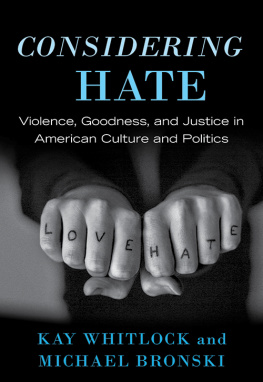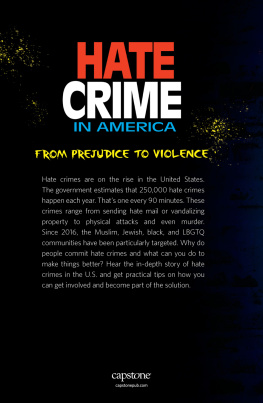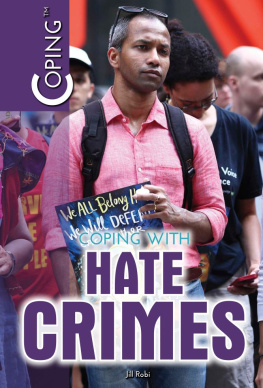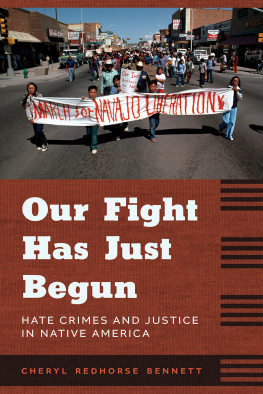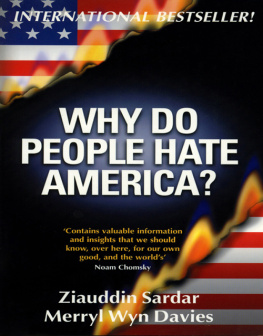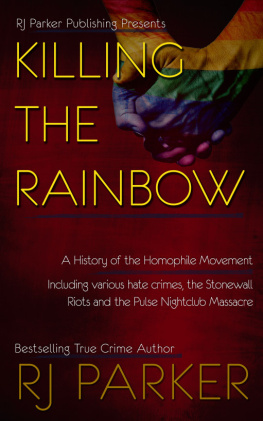
AUTHORS NOTE
Violence directed against vulnerable communities has been a focus of our work as activists and writers for many years. Weve been thinking about the ways that belief in the superiority of some groups and the inferiority of others is foundational to American society; weve been reflecting on what this has to do with how justice is understood and administered in America.
This book emerges from our individual and joint histories. Our inquiry is political, philosophical, psychological, and theological. Significantly, because both of us have always been fascinated by popular culture and its history, our inquiry is also cultural.
KAY WHITLOCK
I am a progressive activist and independent scholar closing in on five decades of organizing and writing about a broad range of social and economic justice topics. Despite growing up in a politically conservative, working-class family in southern Colorado, by the late 1960s I was immersed in the antiVietnam War movement and support work for farmworkers organizing struggles. These were not abstract commitments but responses to my own observations and experiences and the result of listening deeply to others who challenged me to think differently. By the 1970s, I was deeply involved in anti-racism work, feminism, environmental struggles, and an emergent lesbian and gay rights movement (although I felt much more at home when I just started calling myself queer.) All of these commitments intersect and reflect essential parts of myself; theyre never about those people who need help. That I am a Buddhist practitioner also influences how I think about and experience the world.
Ive always existed at the borders of mainstream engagement and radical perspective, a location that is in equal parts a blessing and a curse for all sorts of complicated reasons. But Im there, in part, because from early on I learned the importance of not writing off people just because they dont share my opinions. My experience taught me that the building of relationship and community isnt simply about hunkering down with people who are just like me. My love/hate relationship with popular culture, apparently present from birth, gave me a profound passion for learning from the wildly divergent stories that peopleand societiestell about themselves and one another.
I am most publicly identified with work related to a critique of hate crime laws, the broader conceptual hate frame that so significantly shapes public understanding of violence and justice, and the criminalization of LGBT people in the United States. All of my work has sought to help expose structural forms of violence.
To me, these are intricate areas of inquiry that plunge straight into the heart of how one understands the meaning of community and relationship. In a sense, they constitute a form of social justice teaching riddle: Who am I without a hated and inferior enemy to hold up the mirror so that I may see my own face?
In 2001, just months before the tragic violence of 9/11, the American Friends Service Committee (AFSC) published In a Time of Broken Bones: A Call to Dialogue on Hate Violence and the Limitations of Hate Crime Legislation. This working paper, which I authored, presented AFSCs understanding of the symbiotic relationship between hate violence and structural violence and was circulated widely within social justice circles. Because it questioned the assumptions on which hate crime laws were based, it was immediately controversial.
AFSC was not the only progressive voice raising specific concerns about hate crime laws. Around the same time, so did Carolina Cordero Dyer, then a board member of New York Citys Audre Lorde Project, a center for community organizing among lesbian, gay, bisexual, Two Spirit, transgender, and gender-nonconforming people of color. Yasmin Nair, a Chicago-based activist and academic, was underscoring some of the problems inherent in hate crime laws. And an increasing number of organizations also began speaking out, most of them led by and primarily serving women, transgender, and queer communities of color.
Most striking to me is how many liberal and progressive people and organizations responded to these respectful dissents from hate crime orthodoxy with anger or attempts to silence or marginalize them. This tension is symptomatic of a larger societal unwillingness to come to terms with structural forms of violenceespecially, but not only, racism. Its a refusal that, to the detriment of all, runs like an artery through American culture and politics.
What would happen if we did have that larger conversation about the hate frame? Could any good come of it? Considering Hate says yes.
MICHAEL BRONSKI
I have been involved in gay liberation since 1969. Before that I was active in civil rights work and in the antiVietnam War movement. For most of my life I have been engaged as a writer, journalist, independent scholar, activist, and organizer. Beginning in the 1970s I worked closely with the LGBT press and publishing worlds. In the 1980s I was involved with AIDS activism. During that time I published extensively in the lesbian and gay press, as well as the mainstream press, on issues of sexuality, culture, politics, and sex. In 2000 I was asked to teach a course on LGBT studies at Dartmouth and took my grassroots experience into the academy. This change of career continued when I became Professor of the Practice in Activism and Media in the Studies of Women, Gender, and Sexuality at Harvard University.
Although the trip from Fag Ragthe first national gay male periodical in the country, on which I worked in the 1970sto Harvard has been curious, the one constant has been my desire to examine and explore interactions between culture and politics, between peoples lived lives and how we discuss them intellectually. From an early age, as a self-identified gay boy, I understood the world was not as welcoming or as good as it could or should be. This understanding fueled my political involvements as well as my writing, whether in theater criticism, political commentary, or social history. It was an experience and lesson deeply ingrained. Writing Considering Hate is a continuation of that.
INTRODUCTION
Terrible is the temptation to do good.
BERTOLT BRECHT , The Caucasian Chalk Circle
In considering how central hate is to American discussions about violence and injustice, we wondered why the equally important concepts of goodness and justice were almost always missing. As we began to write about this absence, we realized we needed definitions of these terms that would illuminate and guide our ideas.
Goodness: An awareness, translated into action, of the intrinsic worth and interdependence of all peoples and ecologies, and the determination to dismantle societal structures that support social inequalities and the violence that accompanies them.
Justice: The evolving pursuit of trustworthy, respectful, and nonexploitative relationships, together with accountability for interrupting, preventing, and redressing violence, in its myriad forms, against individuals, peoples, communities, and ecologies.

Hate haunts the human imagination. It is a primal response that engages an individual with the world. By establishing clear personal, social, and political boundaries, it allows us to situate ourselves as people and groups in larger, complex contexts. We feel hate, even revel in it, because it helps us separate good from eviland therefore helps us survive. Because it is so emotionally charged, hate often makes us feel alive. We experience it as an anchor for safety, because it readily slots segments of the population into us and them. We know where we stand: with the good people who are hated by the bad people, or the good people who hate the bad people. Yet the safety we feel is inextricably bound to the anxiety that hate also generates. We know it can engender a counter-hate from the people and groups we despise, thus placing us, arguably, in more danger than before. Tellingly, most people experience themselves not as haters, but as the hated. When they do express hate, it is inevitably in response to

